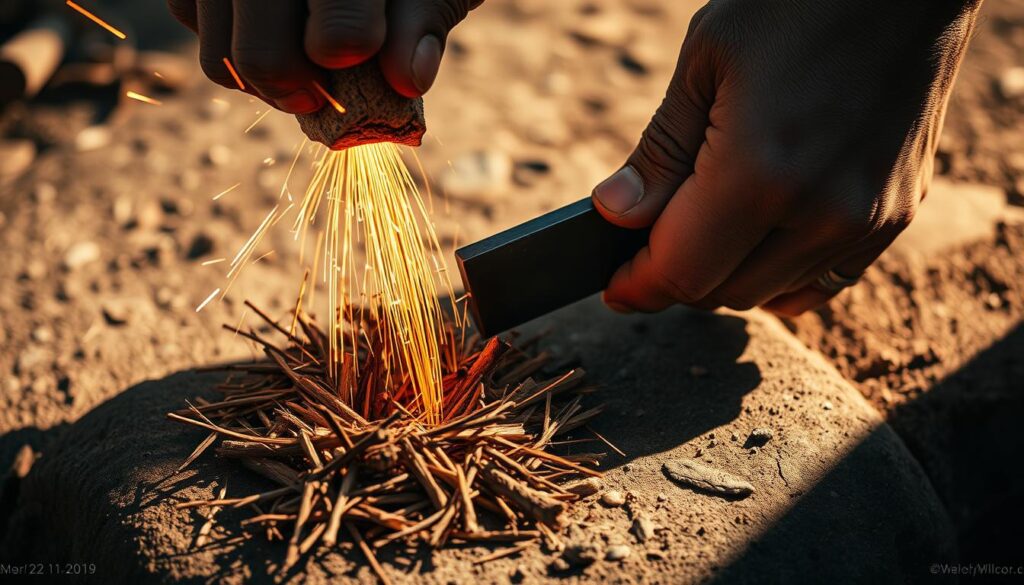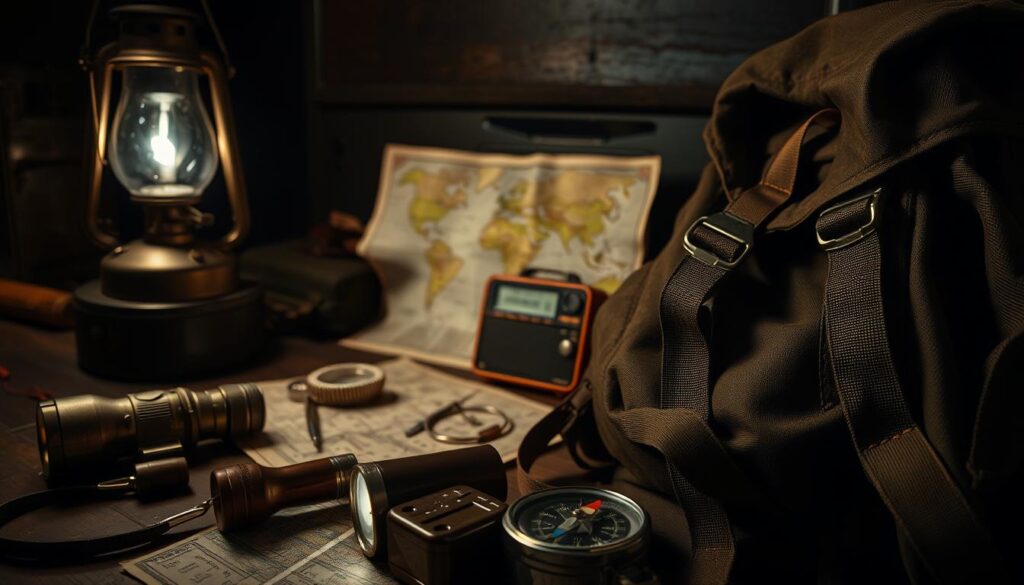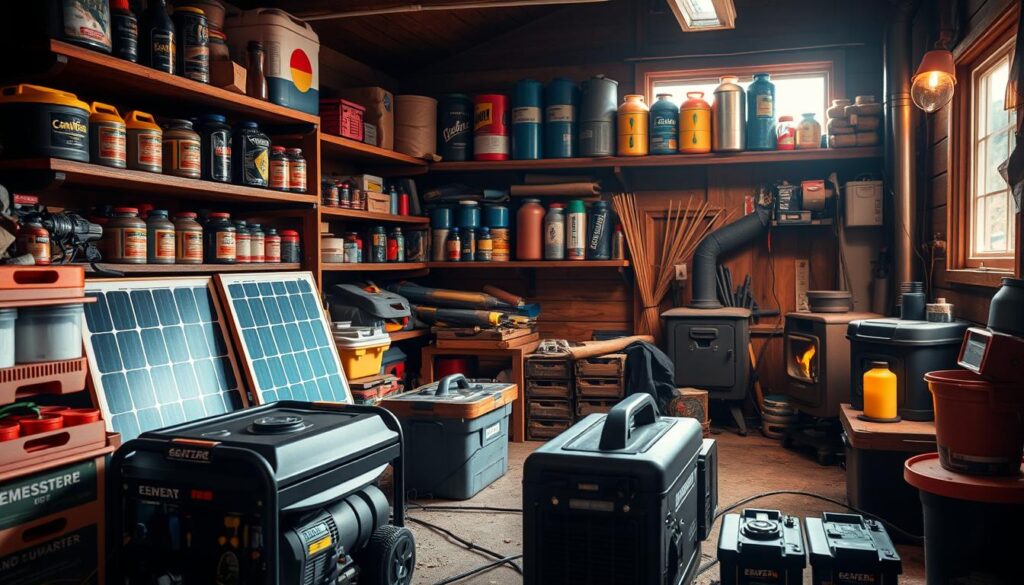As an outdoor enthusiast, I’ve learned that starting a fire can be a lifesaver in a survival situation. One of the most reliable methods is using flint and steel. This ancient technique is both simple and effective.
I’ve found that having a good fire starter is key in outdoor adventures. Flint and steel is a top choice among survivalists. It works by creating sparks when you strike steel against flint, which then ignite tinder.
Mastering this technique requires the right tools, techniques, and safety precautions. I’ll cover all of these in this guide. It will help you become proficient in using this essential survival gear.
Key Takeaways
- Understanding the importance of flint and steel in fire-starting
- Learning the essential tools required for fire-starting with flint and steel
- Mastering the techniques for creating sparks and igniting tinder
- Identifying safety precautions to avoid accidents
- Practicing fire-starting with flint and steel for outdoor adventures
Introduction to Flint and Steel Fire-Starting
Flint and steel fire-starting is a time-tested method. It’s a key outdoor essential for starting fires without modern tools. You need a flint rock and a piece of steel to do it.
The flint rock is hard, usually made of quartz. It sparks when hit with steel. The steel, often high-carbon, can handle lots of strikes. Choosing good materials is key for success.
To start a fire, you must know how to use flint and steel. You strike the steel against the flint to make sparks. These sparks then light tinder to start a fire.
- The flint’s type affects the sparks’ quality and quantity.
- How hard and at what angle you strike matters.
- Good tinder catches the spark and keeps the fire going.
Learning to use a flint fire starter and picking the right tools helps. This way, outdoor lovers can start fires anywhere.
The History Behind Flint and Steel
For centuries, flint and steel have been key for starting fires. They’re used in wilderness survival and emergencies. I’ve learned to value this ancient method for its reliability and rich history.
Flint and steel have been around for ages, used by cultures worldwide. Ancient civilizations knew fire was vital for survival, warmth, and cooking. They’d strike steel against flint to make sparks, then light tinder with them.
Ancient Fire-Making Techniques
In ancient times, making fire was essential for survival. Many cultures developed their own ways, with flint and steel being a top choice. They’d create sparks by striking steel against flint, then catch them with tinder.
The Evolution of Flint and Steel
Over time, the materials for flint and steel have changed. Today’s steel strikers are more effective and last longer. Flint has sometimes been replaced by other materials. Yet, the technique remains a critical skill for wilderness survival gear and emergency fire starters.
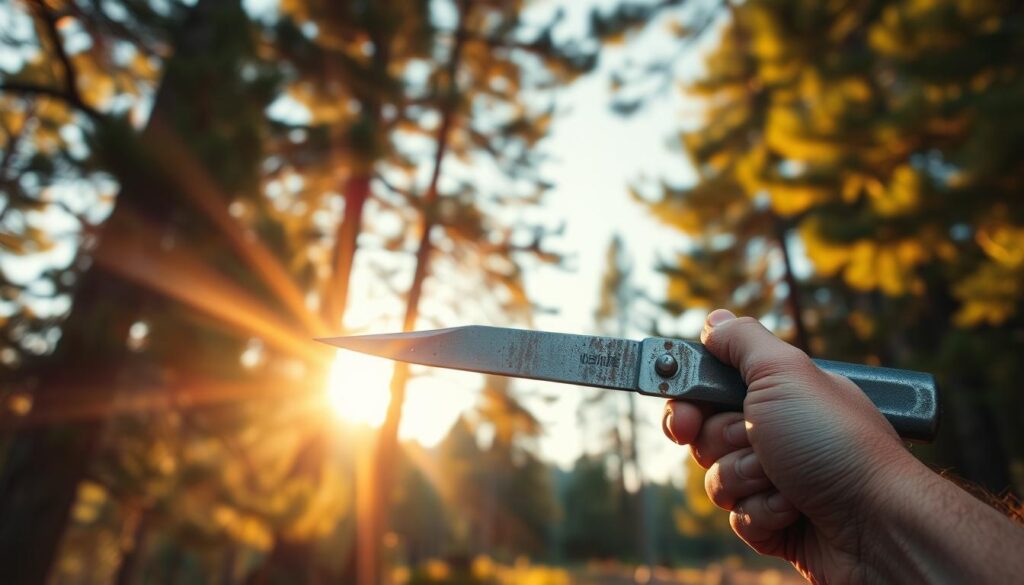
Essential Tools and Materials for Flint and Steel
To start a fire with flint and steel, you need the right tools and materials. The quality of these materials is key to success.
Types of Flint
Flint is essential for starting a fire. High-quality flint makes sparks that can light tinder. You can choose from natural flint or synthetic alternatives. Natural flint is often the best choice because it’s durable and sparks well.
Selecting the Right Steel
The steel should have a lot of carbon. This makes bigger, hotter sparks that can light tinder. High-carbon steel is best for making sparks that start fires.
Other Required Materials
You also need tinder and kindling. Tinder catches the spark and starts to burn. Kindling are bigger sticks that help grow the fire. Choosing the right tinder and kindling is important for starting a fire.
Preparing Your Fire-Site
A well-prepared fire-site is key to starting a fire with flint and steel. It makes your fire safe and efficient. This gives you warmth and light in the wilderness.
Choosing the Right Location
When picking a spot for your fire, consider a few things. Find a place away from flammable materials like dry leaves and branches. It should also have a level surface and little wind to keep the fire under control.
For more tips on starting a fire, check out Wilderness College’s guide on primitive fire-making.
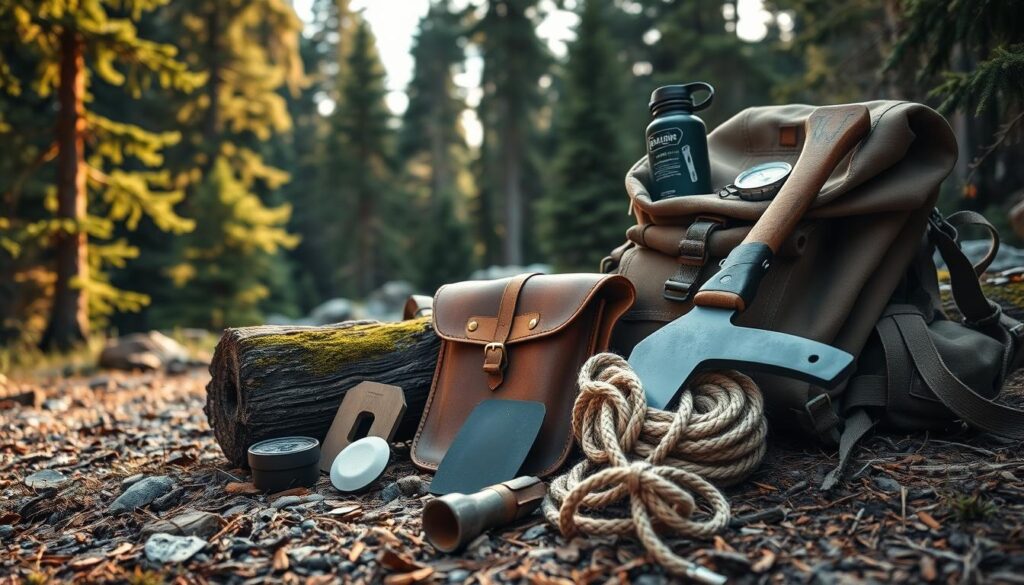
Creating a Safe Fire Bed
It’s important to make a safe fire bed to keep your fire in check. Clear the area of anything that can burn. Then, use rocks to make a fire ring or dig a shallow pit if you’re in an open area.
Make sure your fire bed is at least 15 feet away from any flammable materials. Using a fire pan or portable fire pit is also a good idea. These are part of your outdoor essentials and wilderness survival gear.
By preparing your fire-site well, you’ll have a successful fire-starting experience. You’ll also make your outdoor adventure safer and more enjoyable.
The Fire-Starting Process
The way you strike the flint and steel is key to making sparks. The angle and force of the strike matter a lot. To start a fire, knowing how to strike and aim sparks at tinder is important.
Striking Techniques
Hold the steel striker in one hand and the flint in the other. Place the flint at an angle for a glancing blow. This shaves off hot metal particles that cool into sparks.
Try striking the flint with different forces to find what works best for you.
How to Aim Sparks Effectively
It’s important to aim sparks well to start a fire. Direct sparks at your tinder material. It might take a few tries to catch a spark, so be patient.
Adjust your striking position to get the sparks to land right.
Catching Sparks with Tinder
When a spark hits tinder, make sure it’s enough to catch fire. The tinder should be dry and shredded. Gently blow on it when it smolders to help it ignite.
With the right tinder and a bit of luck, you can start your emergency fire starter.
Learning to start fires with flint and steel ensures you can start fires anywhere.
Choosing the Right Tinder and Kindling
Starting a fire with flint and steel needs the right tinder and kindling. These materials are key to a successful fire. Dry, fluffy tinder is best, and kindling should be small and dry.
Types of Natural Tinder
Natural tinder ignites easily and burns fast. Some top choices include:
- Dry leaves
- Dry grass
- Shredded bark
- Fine dry pine needles
- Birch bark, which is highly flammable
These materials catch sparks well from the flint and steel.
Best Kindling Options
Kindling helps grow the fire once lit. The best options are:
- Small twigs
- Dry sticks
- Thin branches
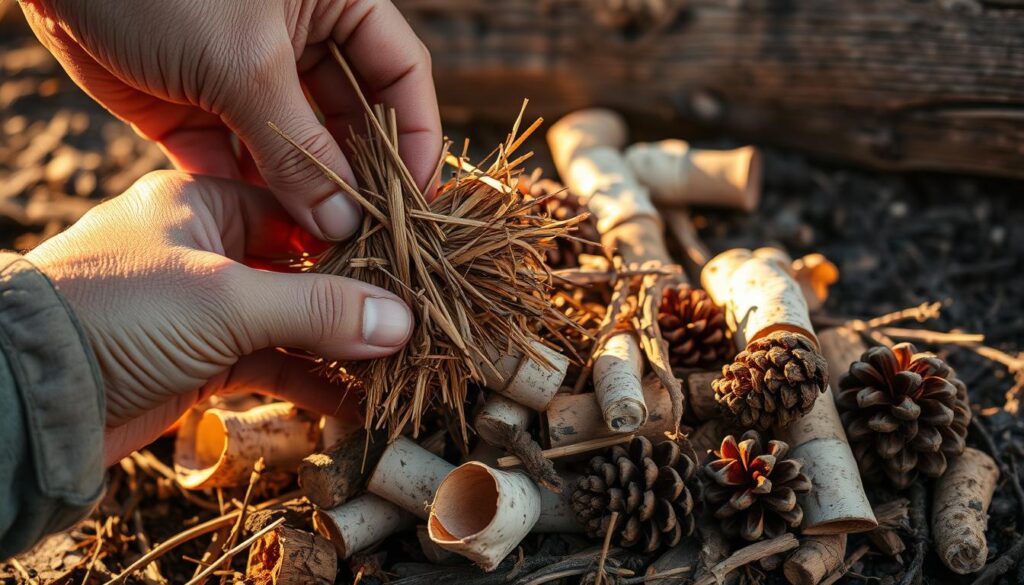
Choosing the right tinder and kindling is vital for starting a fire. Dry, fluffy tinder and small, dry kindling ensure a lasting fire.
Tips for Success in Fire-Starting
Starting a fire with flint and steel can be tough, but it’s doable with the right skills. Knowing the technique, choosing the right materials, and adapting to weather are key. These steps can make fire-starting a reliable skill for outdoor lovers.
Weather plays a big role in starting a fire. Wind, rain, and humidity can make it hard to start and keep a fire going.
Weather Considerations
Before starting a fire, check the weather. Wind can blow out sparks, and high humidity makes tinder hard to light. Here are some tips to help:
- Find a spot that’s protected from wind.
- Use a windscreen or make one to keep your fire safe.
- Keep tinder and kindling dry in a waterproof bag.
For more tips on starting a fire with flint and steel, check out this guide. It offers a detailed look at the technique.
Practice Makes Perfect
Mastering fire-starting with flint and steel takes practice. It’s not just about having the right tools. It’s also about perfecting the technique and adapting to different situations.
Here’s a table with key tips for practicing fire-starting with flint and steel:
| Factor | Tips for Success |
|---|---|
| Technique | Hold the flint and steel at the right angle. Strike with a firm, sharp motion. |
| Tinder Quality | Use dry, fluffy tinder like dry leaves or grass. |
| Weather Conditions | Adjust your technique for different weather, like wind or humidity. |
By understanding these tips and practicing, you can get good at starting fires with flint and steel. This skill is valuable for anyone who loves the outdoors.
Common Mistakes to Avoid
Flint and steel fire-starting is an art that requires avoiding certain mistakes to achieve success. When using an emergency fire starter like flint and steel, understanding the common pitfalls can significantly improve your chances of starting a fire efficiently.
One of the critical aspects of successfully starting a fire is preparing the right materials. This brings us to one of the most common mistakes people make.
Overlooking Tinder Quality
The quality of tinder is key for effective fire-starting. Using poor-quality tinder can lead to frustration and failure to start a fire. It’s essential to select tinder that is dry and highly flammable. Dry leaves, grass, or small twigs make excellent tinder. When choosing tinder, ensure it is free from moisture, as damp tinder will not catch fire easily.
Inadequate Spark Aiming
Another common mistake is failing to aim sparks effectively at the tinder. When using a steel striker to create sparks, it’s important to direct these sparks onto the tinder. Practice is key to mastering the technique of aiming sparks. Hold the flint and steel at the correct angle, and strike in a way that the sparks land on your tinder. This technique, combined with good-quality tinder, will significantly enhance your fire-starting abilities, making you more proficient in using camping tools like flint and steel.
By avoiding these common mistakes, you can improve your chances of successfully starting a fire with flint and steel, ensuring a reliable method for your outdoor adventures.
Safety Precautions to Consider
Starting a fire with flint and steel requires careful attention to safety. It’s about controlling the fire and being ready for emergencies. When I’m in the wilderness, I rely on my wilderness survival gear to survive. So, I must be very careful when starting and keeping a fire.
Fire Control Measures
To keep a fire safe and controlled, several steps are necessary. First, I need to choose a safe location for my fire. This means picking a spot away from things that can catch fire and overhanging branches. I also need to think about the wind direction to stop embers from spreading. Using survival gear like a fire pit or ring helps keep the fire in one place.
- Clear the area of leaves, grass, and other combustible materials.
- If it’s a dry or windy day, consider alternative options or postpone fire-starting.
- Keep a bucket of water or a fire extinguisher nearby.
First Aid for Fire-Related Injuries
Even with precautions, accidents can happen. It’s important to be ready with basic first aid knowledge and supplies. For burns, I should have a first aid kit with burn cream, bandages, and pain relievers. Knowing how to treat burns right can stop further injury and infection.
- Cool the burn with cool or lukewarm water for 10-20 minutes.
- Apply a topical antibiotic ointment and cover the burn with a non-stick dressing.
- Monitor for signs of infection, such as increased redness, swelling, or pus.
By paying attention to these outdoor essentials and taking the right precautions, I can lower the risks of starting a fire with flint and steel. This not only keeps me safe but also helps protect the environment.
Conclusion and Final Thoughts on Flint and Steel
Learning to start a fire with flint and steel is a key outdoor skill. It can save your life in a survival situation. We’ve covered the history, tools, and steps to make a fire in this guide.
Choosing the right flint and steel, preparing a safe spot, and using the right striking techniques are important. These steps help you start a fire in different outdoor settings. Practice often to get better at it.
As you improve your fire-starting skills, you’ll see how reliable and self-sufficient flint and steel are. They’re great for camping, hiking, or emergencies. With the right tools and knowledge, you’ll face outdoor challenges with confidence.
FAQ
What is the best type of flint to use for fire-starting?
High-carbon steel or ferrocerium flint works best. They make sparks well. High-quality flint and steel are made to spark hot, perfect for starting fires.
How do I choose the right steel for flint and steel fire-starting?
Choose a high-carbon steel striker for the best sparks. It should be hard enough to spark when hit against the flint.
What are the essential materials needed for flint and steel fire-starting?
You need flint, steel, tinder, and kindling. Tinder catches the spark. Kindling grows the fire.
How do I prepare a safe fire-site?
Pick a spot away from flammable stuff. Make sure it’s clear of leaves and branches. Protect it from wind. Clear a circle of about three feet to make a fire bed.
What is the proper technique for striking the flint and steel?
Hold the flint and steel at a 30- to 40-degree angle. Strike the steel against the flint to make sparks. Aim them at the tinder.
What types of tinder are suitable for flint and steel fire-starting?
Use dry, fluffy, and combustible tinder. Good examples are dry leaves, grass, small twigs, and dry pine needles.
How can I improve my chances of successfully starting a fire with flint and steel?
Practice makes perfect. Be ready for different weather by having various tinder and kindling.
What are some common mistakes to avoid when using flint and steel for fire-starting?
Avoid using bad tinder, not aiming sparks right, and not preparing a good fire-site.
What safety precautions should I take when using flint and steel for fire-starting?
Always have a plan to control the fire. Be ready to put it out if needed. Keep a first aid kit for fire injuries.
Can I use flint and steel in wet or damp conditions?
Starting a fire in wet or damp is harder. But, it’s possible with the right materials and techniques. Look for dry tinder and kindling. Be ready to work harder to spark.

